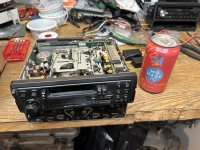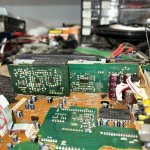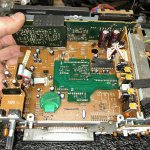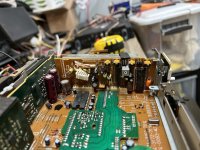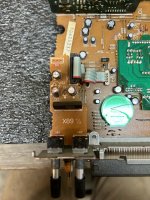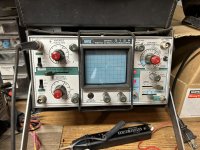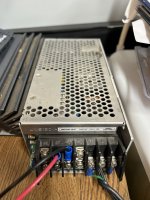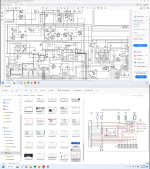Hello, first time poster. I'm trying to diagnose and repair a vintage Kenwood KRC-530 cassette deck. I picked it up from Pick n Pull so I don't know it's history unfortunately.
Can anybody help me narrow down which board I should start testing on this head unit? I believe I am going to have to de-solder the power IC board to be able to test it.
The main issue I have found so far is that the volume output is very low, and it will make a loud pop every few seconds and go quiet. This happens on all the channels.
If I turn down the treble and bass controls I can actually turn it up all the way without pops. If the treble and bass controls are at their normal spots (0 db) it will start to pop at very low volume. At higher volume the pop is so large you can literally see the speaker cone jump. (I'm using an old speaker that I can toss if it gets damaged). But even at full volume the output is pretty low.
I also tested the output from the RCA through a known good amp. With the amp gain on full and the radio volume maxed out you can barely hear anything. But no pops.
Someone had replaced the fuse in the main yellow power lead with a 5 amp fuse instead of a 3.5 amp fuse, so I replaced that and it didn't pop when I fired it up again. But I'm assuming something happened that blew that fuse at some point.
I checked the RCA grounds and the resistance is only 0.3 ohms, so I believe that's good.
I don't see any obviously burnt areas in the head unit, but some of the boards can't really be inspected without de-soldering them.
Based on Perry's guide it sounds like one of the speaker leads might have been accidentally grounded, blowing the main amp.
But the fact that the pops go away when the tone controls are turned all the way down makes we wonder about the tone control board and IC.
Some background on me...
I have a mechanical engineering degree (30 years ago now) and know the basics of electrical engineering and electricity, but trying to learn more about car audio (and some home audio) for a couple reasons.
1. It's something new to learn, especially since I was into Car Audio in the 90s when I was single and had a good paying engineering job.
2. It's a new project I can work on when it's cold in the garage. My normal hobby is repairing and restoring vintage cars, but I don't always feel like being in a cold garage or getting super dirty, especially at night. And with small kids I don't often have enough time to start a big welding project, or dive into a suspension repair etc.
3. My dad was an electrical engineer. That gene didn't pass on to me, but his love and ability fix stuff did. He now has dementia, and this somehow makes me feel closer to him. Crazy, but somehow true.
Anyway, I have been reading up. A couple books on repairing electronics, going though Perry's guides (and I will likely buy the full tutorial once I finish the basic stuff), and I found CrazyLogix excellent YouTube videos. I have a Rockford amp I want to repair at some point, but after watching CrazyLogix repair videos I'm going to hold off on that one until I have more experience.
I have picked up a few amps cheap, the Rockford I mentioned above, an ADS PowerPlate 100, a vintage Coustic 380, and an older Kenwood and Pioneer. The Pioneer needed a capacitor and RCA resoldered and then worked fine. The rest all test fine. Could probably use new caps at some point, but are working currently.
Unfortunately this head unit needs help, and they don't seem quite as easy to work on! But I only paid $10 for it so it's a great place to start.
I do have a good Weller soldering station, Fluke meter, a stable power supply, and recently picked up a scope. Now I just need to figure out how to start testing stuff, I'm guessing I need to start with the power and preamp FETs.
Thanks if you made it this far!
Ian - autoarcheologist
Can anybody help me narrow down which board I should start testing on this head unit? I believe I am going to have to de-solder the power IC board to be able to test it.
The main issue I have found so far is that the volume output is very low, and it will make a loud pop every few seconds and go quiet. This happens on all the channels.
If I turn down the treble and bass controls I can actually turn it up all the way without pops. If the treble and bass controls are at their normal spots (0 db) it will start to pop at very low volume. At higher volume the pop is so large you can literally see the speaker cone jump. (I'm using an old speaker that I can toss if it gets damaged). But even at full volume the output is pretty low.
I also tested the output from the RCA through a known good amp. With the amp gain on full and the radio volume maxed out you can barely hear anything. But no pops.
Someone had replaced the fuse in the main yellow power lead with a 5 amp fuse instead of a 3.5 amp fuse, so I replaced that and it didn't pop when I fired it up again. But I'm assuming something happened that blew that fuse at some point.
I checked the RCA grounds and the resistance is only 0.3 ohms, so I believe that's good.
I don't see any obviously burnt areas in the head unit, but some of the boards can't really be inspected without de-soldering them.
Based on Perry's guide it sounds like one of the speaker leads might have been accidentally grounded, blowing the main amp.
But the fact that the pops go away when the tone controls are turned all the way down makes we wonder about the tone control board and IC.
Some background on me...
I have a mechanical engineering degree (30 years ago now) and know the basics of electrical engineering and electricity, but trying to learn more about car audio (and some home audio) for a couple reasons.
1. It's something new to learn, especially since I was into Car Audio in the 90s when I was single and had a good paying engineering job.
2. It's a new project I can work on when it's cold in the garage. My normal hobby is repairing and restoring vintage cars, but I don't always feel like being in a cold garage or getting super dirty, especially at night. And with small kids I don't often have enough time to start a big welding project, or dive into a suspension repair etc.
3. My dad was an electrical engineer. That gene didn't pass on to me, but his love and ability fix stuff did. He now has dementia, and this somehow makes me feel closer to him. Crazy, but somehow true.
Anyway, I have been reading up. A couple books on repairing electronics, going though Perry's guides (and I will likely buy the full tutorial once I finish the basic stuff), and I found CrazyLogix excellent YouTube videos. I have a Rockford amp I want to repair at some point, but after watching CrazyLogix repair videos I'm going to hold off on that one until I have more experience.
I have picked up a few amps cheap, the Rockford I mentioned above, an ADS PowerPlate 100, a vintage Coustic 380, and an older Kenwood and Pioneer. The Pioneer needed a capacitor and RCA resoldered and then worked fine. The rest all test fine. Could probably use new caps at some point, but are working currently.
Unfortunately this head unit needs help, and they don't seem quite as easy to work on! But I only paid $10 for it so it's a great place to start.
I do have a good Weller soldering station, Fluke meter, a stable power supply, and recently picked up a scope. Now I just need to figure out how to start testing stuff, I'm guessing I need to start with the power and preamp FETs.
Thanks if you made it this far!
Ian - autoarcheologist
Attachments
Does it do this through the RCAs and at speaker level?
Does it do it on AM, FM and cassette?
I couldn't find a free version of the service manual. Without it, you may be left to looking at points like on the inputs and outputs of the electronic volume control IC.
Does it do it on AM, FM and cassette?
I couldn't find a free version of the service manual. Without it, you may be left to looking at points like on the inputs and outputs of the electronic volume control IC.
It does it on FM, I can check AM as well. I can't really check the cassette because the belt I believe has stretched too much. It will move a little bit in FF or Rev, but doesn't move in Play. I think I see what you're getting at.
Through the RCA's I didn't hear a pop, but the volume is barely audible. I will try it again.
I do have a service manual, I forgot to include that. This should be a link to it:
https://drive.google.com/file/d/1NQpqd9kFSAjAMOUMK5Vxus6hrsAz-Dfy/view?usp=sharing
Through the RCA's I didn't hear a pop, but the volume is barely audible. I will try it again.
I do have a service manual, I forgot to include that. This should be a link to it:
https://drive.google.com/file/d/1NQpqd9kFSAjAMOUMK5Vxus6hrsAz-Dfy/view?usp=sharing
Well, that makes a difference. I copied and pasted the title and the number was wrong.
Did you learn to use the scope?
Did you learn to use the scope?
I saw something pop up and I gave you access, did it work?
I used a scope back in school, I haven't tried this one yet but I think I can get it going. What I don't have unfortunately is signal generator. I know there are tones available online, but I don't have a benchtop version.
BTW I'm honored to have your help! I don't follow celebrities, but I'm a bit awestruck that you're helping me.
I used a scope back in school, I haven't tried this one yet but I think I can get it going. What I don't have unfortunately is signal generator. I know there are tones available online, but I don't have a benchtop version.
BTW I'm honored to have your help! I don't follow celebrities, but I'm a bit awestruck that you're helping me.
I'm just an average tech. Nothing more.
You can use virtually anything for a signal generator. The audio files can be anything from music to sine waves to pink noise. You likely already have music. The files you want, other than that can be generated by Audacity.
Set the scope up and get used to using it on various points in an amplifier or this head unit. Did you read the oscilloscope page I recommended?
You can use virtually anything for a signal generator. The audio files can be anything from music to sine waves to pink noise. You likely already have music. The files you want, other than that can be generated by Audacity.
Set the scope up and get used to using it on various points in an amplifier or this head unit. Did you read the oscilloscope page I recommended?
Your page? Yes! https://www.bcae1.com/oscope.htm
I have also read through the scope section in the book I mentioned.
I will set up the scope and start learning how to use it today. I’m heading out of town to help my folks move into an independent living facility this week so with the flight and downtime I will have plenty of time to keep reading. So I will finish up your basic course. Then hopefully I can get going again next week
Thanks again!
I have also read through the scope section in the book I mentioned.
I will set up the scope and start learning how to use it today. I’m heading out of town to help my folks move into an independent living facility this week so with the flight and downtime I will have plenty of time to keep reading. So I will finish up your basic course. Then hopefully I can get going again next week
Thanks again!
What make/model scope did you buy?
Read this as well. Download it before you fly if you can't get internet access on the plane.
https://download.tek.com/manual/070869001.pdf
Read this as well. Download it before you fly if you can't get internet access on the plane.
https://download.tek.com/manual/070869001.pdf
Last edited:
Thanks, that should keep me entertained!
The scope isn’t super powerful, it’s a AWS model 315P I found locally from someone who had retired from Intel. But it should get me started and I can upgrade if needed.
I picked up this power supply when HP was downsizing our offices. It’s worked great for years. I need to come up with a better mount to clean up my bench a little, but I have it running through a 10A fuse block into a power strip that I can plug multiple amps or radios into. Messy but functional.
The scope isn’t super powerful, it’s a AWS model 315P I found locally from someone who had retired from Intel. But it should get me started and I can upgrade if needed.
I picked up this power supply when HP was downsizing our offices. It’s worked great for years. I need to come up with a better mount to clean up my bench a little, but I have it running through a 10A fuse block into a power strip that I can plug multiple amps or radios into. Messy but functional.
Attachments
I'm back. I spent a few hours last night and today poring over the wiring diagram, trying to make sense of it.
I also read through most of the rest of Perry's manual, thank you so much for putting that together. Next up I need to purchase the full version.
But just now I was able to find the power amp and test for voltage at all 17 points. They all came in close to what they should be. My next guess is that I've got a cap or two going bad somewhere based on other research, but I think the best option at this point is to get the full repair manual and follow the steps in there.
Perry thanks so much for all your help so far! Now that I'm back I can hopefully focus on this a bit more and get this old deck working properly.
I also read through most of the rest of Perry's manual, thank you so much for putting that together. Next up I need to purchase the full version.
But just now I was able to find the power amp and test for voltage at all 17 points. They all came in close to what they should be. My next guess is that I've got a cap or two going bad somewhere based on other research, but I think the best option at this point is to get the full repair manual and follow the steps in there.
Perry thanks so much for all your help so far! Now that I'm back I can hopefully focus on this a bit more and get this old deck working properly.
What page of the SM has the 17 voltages that you checked?
Is the DC voltage on all speaker terminals approximately 1/2 of the B+ voltage?
Do they remain at 1/2 voltage or does the voltage pulse to ground repeatedly?
If you're referring to the full repair tutorial, email me. Sales are not allowed on this forum.
babin_perry@yahoo.com
Is the DC voltage on all speaker terminals approximately 1/2 of the B+ voltage?
Do they remain at 1/2 voltage or does the voltage pulse to ground repeatedly?
If you're referring to the full repair tutorial, email me. Sales are not allowed on this forum.
babin_perry@yahoo.com
As a side note, the following PDF viewer offers many more features than the Adobe reader. There is a link on the page for the editor version that has more features but is larger and takes a tiny bit longer to load. For as many PDF files as I open, I use the smaller version.
https://www.majorgeeks.com/files/details/pdf_xchange_viewer.html
https://www.majorgeeks.com/files/details/pdf_xchange_viewer.html
I checked the speaker voltages tonight. You were right, they are about 5V then pulse to ground, and pulse to 10V.
Email incoming.
Email incoming.
Is it heating up?
Do you have one or more that aren't going to 1/2 B+ like the majority of the others?
Do you have one or more that aren't going to 1/2 B+ like the majority of the others?
I can't really tell if it's heating up.
But it's pulsing to ground on all the speaker outputs, and both RCA preamp outputs.
But it's pulsing to ground on all the speaker outputs, and both RCA preamp outputs.
- Home
- General Interest
- Car Audio
- Help diagnosing issues with Kenwood KRC-503
